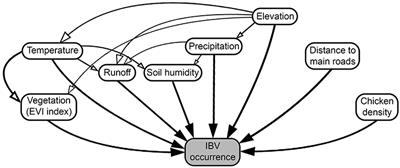Description
Filoviruses, Marburg virus and Ebola virus cause severe hemorrhagic fever with high mortality in humans and nonhuman primates. Among the most promising filovirus vaccines in development is a system based on recombinant vesicular stomatitis Indiana virus (rVSIV) that expresses an individual filovirus glycoprotein (GP) instead of the VSV glycoprotein (G). The main concern with all replication-competent vaccines, including rVSV filovirus GP vectors, is their safety. To address this concern, we conducted a neurovirulence study using 21 cynomolgus macaques where the vaccines were administered intrathalamicly. Seven animals received an rVSV vector expressing the Zaire ebolavirus (ZEBOV) GP; seven animals received an rVSV vector expressing Lake Victoria marburgvirus (MARV) GP; three animals received rVSV wild-type (wt) vector and four animals received vehicle control.
Two of the three animals receiving rVSV-wt showed severe neurological symptoms, whereas animals receiving vehicle control, rVSV-ZEBOV-GP, or rVSV-MARV-GP did not develop these symptoms. Histological analysis revealed significant lesions in the neural tissues of all three rVSV-wt animals; however, no significant lesions were observed in any animals in the filovirus vehicle or vaccine control groups. These data strongly suggest that the rVSV filovirus GP vaccine vectors lack the neurovirulence properties associated with the parent rVSV-wt vector and support their further development as a vaccine platform for human use.

Purity: greater than 85% as determined by SDS-PAGE.
Destination Names: P
Uniprot No.: P04879
Research Area: Others
Alternative Names: Protein P; M1 protein
Species: Vesicular stomatitis Indiana virus (Glasgow strain) (VSIV)
Source: E.coli
Expression Region: 1-265aa
Mole Weight: 34.9 kDa
Protein Length: Total length
Tag information: N-terminal 10xHis-tagged and C-terminal Myc-tagged
Form: Liquid or Lyophilized Powder
Note: We will preferably ship the format we have in stock, however, if you have any special requirements for the format, please remark your requirement when placing the order, we will prepare according to your demand.
Buffer
If the dosage form is liquid, the default storage buffer is Tris/PBS based buffer, 5%-50% glycerol. If the administration form is a lyophilized powder, the buffer before lyophilization is Tris/PBS-based buffer, 6% trehalose, pH 8.0.
Reconstitution
We recommend that this vial be briefly centrifuged before opening to bring the contents to the bottom. Reconstitute protein in sterile deionized water at a concentration of 0.1-1.0 mg/mL. We recommend adding 5-50% glycerol (final concentration) and an aliquot for long-term storage at -20°C/-80°C. Our final default glycerol concentration is 50%. Customers could use it for reference.
Storage Conditions
Store at -20°C/-80°C upon receipt, need to be aliquoted for multiple uses. Avoid repeated cycles of freezing and thawing.
Shelf life
Shelf life is related to many factors, storage condition, buffer ingredients, storage temperature and the stability of the protein itself. Generally, the shelf life of the liquid form is 6 months at -20°C/-80°C. The shelf life of the lyophilized form is 12 months at -20°C/-80°C.
Delivery time: 3-7 business days
Notes: Repeated freezing and thawing is not recommended. Store working aliquots at 4°C for up to one week.
Materials And Methods
A total of 21 healthy male cynomolgus macaques (Macaca fascicularis) (4-7 kg) were purchased from Charles River Laboratories (Wilmington, MA). All animals were between 4 and 6 years of age with the exception of two animals (67-01, 68-01) that were 18 years old. The study was conducted at the New England Primate Research Center (PRC), Harvard Medical School, and the animals were cared for in accordance with the standards of the Association for the Evaluation and Accreditation of Laboratory Animal Care. and the Harvard Medical School Animal Care and Use Committee.

All animal work adhered to the regulations outlined in the USDA Animal Welfare Act (9 CFR, Parts 1, 2, and 3) and the conditions specified in the Guide for the Care and Use of Laboratory Animals (ILAR publication, 1996, National Academy Press) and by the Harvard Medical School Animal Care and Use Committee. These experiments and procedures were approved by the Harvard Medical Area Standing Committee on Animals. Any clinical signs of illness or distress were immediately reported to the responsible veterinarian, who recommended treatment of minor ailments or euthanasia when clinical observations and neurological scores of the animals reached levels based on the protocol approved by the Care Committee. and Use of Animals from Harvard Medical School.
- Haematology and serum biochemistry
Total white blood cell counts, white blood cell differentials, red blood cell counts, platelet counts, hematocrit values, mean cell volume, mean corpuscular volume, and mean corpuscular haemoglobin concentration were determined from Blood samples collected in tubes containing EDTA, using a laser-based haematology analyzer (Hemavet, Drew Scientific, Waterbury, CT).
Albumin, amylase, globulin, alanine aminotransferase, aspartate aminotransferase, alkaline phosphatase, gamma-glutamyltransferase, lactate dehydrogenase, glucose, cholesterol, total protein, total bilirubin, direct bilirubin, urea nitrogen, creatinine, creatinine kinase, triglycerides, bicarbonate, calcium, phosphorus, chloride, potassium, and sodium were measured by IDEXX VetConnect (Westbrook, ME) using an Olympus AU5421 chemistry analyzer (Olympus Americas, Center Valley, PA).
- Necropsy and tissue collection
Animals were euthanized if neurological signs developed or at the scheduled study endpoint, 21 days after inoculation, with an overdose of intravenous sodium pentobarbital and necropsied immediately thereafter. Tissues from five brain regions (frontal cortex (FC), occipital cortex (OC), cerebellum (CB), thalamus (TH), and basal ganglia (BG)) and three spinal cord (SC) regions (cervical, thoracic, and lumbar ) were collected in 10% neutral buffered formalin. After one week of fixation, the brain was sectioned into right and left hemispheres and specific brain regions were trimmed and embedded in paraffin, sectioned at 5 µm, and stained with hematoxylin and eosin. (H&E).
To assess whether there was virus replication in nasal, oral, and rectal swabs (days 0, 2, 4, 7, 14, and 21), blood (days 0, 2, 4, 7, 14, and 21), non-neural tissues (spleen, liver, kidney, heart, axillary lymph node and adrenal gland) and neural tissues (FC, BG, OC, TH, CB, BS and SC) virus titers were determined by standard plaque assay on Vero monolayer cells. Swabs were collected and plated in D-10 medium, while tissues were plated in D-10 medium and then homogenized prior to plating assay.









